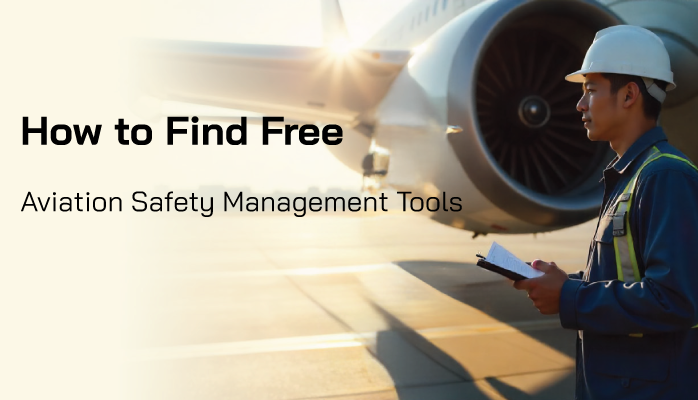Aviation Safety Managers Need SMS Management Tools

Safety managers are resourceful professionals. Their respective companies demand that they provide results on extremely limited budgets. Many times safety managers are appointed without adequate training. In these cases, safety managers are kicked into the deep end of the swimming pool.
Sink or swim, safety manager.
Most often, the accountable executive doesn't understand all the documentation requirements in an aviation safety management system (SMS). Top management seldom gets into the weeds. It is up to safety managers to educate accountable executives on what is required in the SMS unless they have been fortunate enough to have taken SMS training for executives.
Related Aviation Safety Manager Articles
- Career Advice for Aspiring Aviation Safety Managers
- What Makes a Good Aviation Safety Manager?
- How to Manage Aviation SMS Budget Expectations - for Safety Managers
It is rare that a top executive will know the four ICAO components or pillars of aviation safety management:
- Safety Policy;
- Safety Risk Management;
- Safety Assurance; and
- Safety Promotion.
And I bet it is rare for any upper-level manager to understand not only
- how much work it takes initially to implement an SMS, but
- how much work it takes to keep the SMS running?
In order to be effective, safety managers need quality aviation SMS tools that can fit most budgets and are free. Not every aviation service provider needs advanced SMS database tools to comply with SMS documentation requirements. However, there are a few indicators that guide you to determine which tools you will need and later expect to "grow into" as the aviation SMS matures.
The best tool to determine future SMS data management requirements will be the gap analysis. Review this to get an idea of what to expect five or ten years down the road.
Smaller operators with 20 to 30 employees can get buy using spreadsheets unless there is high employee turnover. In this case, an accountable executive is advised to spend a couple of hundred dollars a month and get an online SMS database subscription. This will be the least amount of risk and ensure the continuity of the SMS when the safety manager decides to take his learned skills and "graduate" to a larger company.
When your SMS data management strategy is forced to be a "spreadsheet SMS," the accountable executive needs assurance that the data does not leave when the safety manager leaves. For example, we have seen safety managers leave the company with all SMS data on their laptops. Another equally bad scenario is that your spreadsheets are stored in Google Drive or another cloud storage platform that only the safety manager can access.
Related Articles on Using Spreadsheets in Aviation SMS
- 5 Things Spreadsheets Can't Do for Your SMS
- Spreadsheets vs Software for Aviation Safety Management
- See How Spreadsheet Not EASA Compliant Aviation Hazard Reporting Database
Managing Limited Aviation SMS Budgets

Small companies don't have much SMS budget. And why should they spend lots of money on SMS when there is no quantifiable benefit? In every company, there are finite limits as to:
- How much SMS implementations will save the company;
- How much SMS budget the company can support; and
- Production limits (revenue generated from sales) to support operations, including the SMS.
Safety managers must be aware of these limits when calculating "how much safety can we afford this year?"
In smaller organizations, line employees are commonly assigned to be the "safety manager." They may be
- pilots,
- line-mechanics,
- airport equipment operators, or even
- administrative assistants.
These employees have their "regular job duties" as well as being the "part-time safety manager."
In these cases, these "part-time safety managers" don't have time to devote their entire days to managing SMS documentation. It becomes more cost-effective to spend a few hundred dollars a month on SMS database tools to amplify the efforts of the "part-time" safety manager than to hire a dedicated employee as the "safety manager."
Based on past observations, companies with 80 to 100 employees begin to have a full-time safety manager. Smaller aviation service providers assign the safety manager position to existing employees demonstrating:
- Technical savvy;
- Organizational skills; and
- Effective communication (both verbal and written).
When the pilot (or another employee) is assigned to be the "safety manager," he needs to understand "what is the budget for the SMS?" Many Web-based SMS software solutions for only a few hundred dollars per month will make the job of managing the SMS more "sustainable" than spreadsheets. Don't get me wrong. Don't get the cheapest solution. Make sure the SMS database aligns with business objectives. If you need to get to stage 3 of an IS-BAO audit, don't get PRISM or another cheap solution with pretty pictures. Do your research!
I have seen safety managers struggle to "save the company" a few dollars each month only to realize much later that their "spreadsheet SMS" is not sustainable in the long run. Or they chose the wrong SMS database that will not satisfy their long-term business objectives.
Attempting to manage all SMS documentation requirements becomes a juggling act between the employee's "assigned job" and their part-time job. This constant juggling of duties creates unnecessary stress on safety managers leading to burnout and a failed SMS, or at best, a "paper SMS."
The SMS database is the proper technology to manage SMS documentation requirements, especially for smaller companies that have high turnover or those attempting to demonstrate a mature SMS that effectively manages safety risk management (SRM) and safety assurance (SA) processes.
Related Aviation SMS Database Articles
- How to Manage Aviation SMS Without Complex Databases
- How to Choose the Best Aviation Safety Database Software
- 5 Most Important Things to Know Before Buying Aviation SMS Database
Managing SMS Software Without Budget - Forced to Use Free SMS Tools

I understand that there are cases when an operator does not have the budget for SMS tools. In this case, free aviation SMS tools are available on the Web to download. These tools are also available in Web-based SMS database programs. The major difference is that you won't have access to:
- Email notifications when tasks are overdue;
- SMS performance monitoring tools accessible by all managers;
- Automatic chart and report generation;
- Safety reporting system integrated into the SMS' risk management system;
- Real-time dashboards;
- SMS implementation monitoring tools; or
- Hazard register integrated into risk management tools.
Auditors love to see these features as they demonstrate "capability" to effectively manage an aviation SMS. We realize not every operator needs these features. There is a limit that is defined by each company as to "how much safety can we afford?" In some cases, the business case does not support acquiring time/labor-saving SMS database tools. These cases include:
- Poor regulatory SMS oversight (why comply if there are no repercussions?);
- No immediate requirement for SMS (SMS is optional);
- Short-term business strategy for operating within a particular region/industry (two to four years before the regulators or client catches on);
- Satisfying a contractual obligation to demonstrate a semblance of a working SMS (used to acquire contract without interest in implementing SRM and SA processes); or
- Production activities do not support "added safety costs."
Before the safety manager determines whether a spreadsheet SMS is adequate, the accountable executive and the safety team need to ensure the business goals are aligned with SMS goals and objectives. This will ensure that the accountable executive is getting what he needs -- not more, and not less. If the accountable executive has a short-term business strategy, the SMS must complement the business strategy.
When long-term objectives are desired, then an SMS database is the best recommendation. The SMS database adds value to department heads also. They can more easily manage corrective actions and communicate risk to employees from the SMS database.
If you are struggling to convince the accountable executive on the business case for acquiring an SMS database to reduce organizational risk, then I recommend showing department heads the value of such a system. Department heads become SMS champions whenever you show them benefits that affect their ability to make timely decisions based on better data management activities.
SMS is a process that never stops. Before the safety team preaches SMS to employees and tells them to report every minor incident and close call, the safety team must be prepared to manage all these reported safety issues. This entails
- coordinating the creation and tracking of corrective and preventive actions;
- classifying issues for later trend analysis;
- performing and documenting investigations;
- communicating risk to employees; and
- ensuring SMS tasks are completed on time.
A spreadsheet SMS will not work for small to mid-sized companies that have healthy reporting cultures. These are a few thoughts from observing the SMS industry mature over the past dozen years. I'm not trying to sell you anything. I'm just sharing what I've seen and learned since 2007. I've been fortunate to see the Canadians' and Australians' SMS mature and see the trends in their SMS data management strategies.
This article will demonstrate how to find free aviation safety management tools. We will also offer some links to best-in-breed reference sites that offer free SMS tools.
Related Articles on Aviation SMS Budget
- Why Money Is More Important Than Safety in Aviation
- Why Aviation Safety Managers Fail Without Dept Head Support in SMS
- 4 Safety Charts for Department Heads Issue Management Performance
How to Search for Free Aviation SMS Tools

The first tip for discovering SMS tools is to use Google. Without a doubt, Google is the best search engine. I won't go into why, as this is outside the scope of this article.
When you are performing a search, type your search in the form of a question, such as:
- "How to perform a risk assessment in aviation SMS" or
- "What are the requirements of passing an aviation SMS audit."
In the past couple of years, Google has been getting smarter and is now conditioned to answer questions.
Next, when performing a search for free aviation SMS tools, use specifics. For example, a gap analysis is a checklist, and we know that there are several models, such as:
- ICAO;
- FAA;
- Transport Canada; and
- IS-BAO.
In this case, you want to structure your search like:
- "free icao gap analysis checklists;" or
- "free icao gap analysis tools."
If you don't care whether the checklist is free, don't add it. But since this is an article about finding free aviation safety management tools, I thought I would add it.
Related Aviation SMS Gap Analysis Articles
- What Is a Gap Analysis in Aviation SMS?
- SMS First Steps - Gap Analysis
- 4 Best Aviation SMS Gap Analysis Strategies for SMS Implementations
Indirect Route to Find Free SMS Checklists, Templates, and Tools
Many aviation safety training companies offer resources. The best I have ever seen for free aviation SMS tools and resources was ATC Vantage, now discontinued as of 2018. ATC Vantage had some VERY good resources and I loved their site because they kept the documents on their servers instead of redirecting users to the source.
What I liked about ATC Vantage's approach to serving up free SMS tools on their server is that they kept older versions. For example, ICAO Document 9859 (the aviation SMS bible) is in the third edition, coming onto the fourth. ATC Vantage had all three editions. I'm really saddened to see their site go offline.
The problem with getting free tools is that everybody likes "free stuff," but free doesn't pay the bills for the time and energy to put these resources together and host them on the Web. Since ATC Vantage has gone the way of the dodo bird, SMS Pro appears to be the best source to acquire free SMS tools. I'm sorry to say this because I really liked the people at ATC Vantage.
For those who have been in the aviation safety world for a few years, these older editions are great reference documents.
SKYbrary also offers great SMS resources and tools, but SKYbrary isn't as user-friendly as ATC Vantage.
Civil Aviation Authorities Sometimes Offer Exceptional SMS Tools
This is a hit or miss. Some CAAs are great, while others offer little more than a download to ICAO doc 9859. One point to NOT OVERLOOK, many of these resources have SMS tools in the appendices. Not all of them are good, so look around and compare
The best CAA resource for aviation SMS tools in Australia Civil Aviation Safety Authority (CASA). For over a dozen years, I've been impressed with the quality, consistency, and quantity of their SMS tools and guidance material. My frustration, however, is that I cannot find archived documentation that I found useful in the past.
The second best CAA resource for aviation SMS guidance material and tools is Transport Canada. I rate them higher than the FAA because the FAA has not been very consistent in their documentation, just as they have been slow in rolling out SMS in the United States.
Don't get me wrong. The FAA does put out some good SMS tools occasionally, but I personally have a hard time finding them. The FAA's Safety Management System page has a resource page for Safety Management System Links. Am I the only person who is underwhelmed? I should not complain, because I did learn a lot from AC 120-92 and the resulting SMS Assurance Guide. I was pleased that the FAA did release AC 120-92B. AC 120-92B is an excellent resource for new SMS implementations, regardless of whether you are operating under 14 CFR Part 5 rules.
MITRE's safety management systems department does a great job with resources and training. I believe MITRE does a better job than the FAA for documents. Definitely worth checking out their free aviation SMS tools. Note that their SMS tools are not always original, but who cares? Why reinvent the wheel? The aviation SMS community is about enhancing aviation safety and sharing wherever we can.
New Zealand has surprised me with their SMS guidance material.
Related Aviation SMS Implementation Articles
- Why Should We Implement Aviation SMS?
- How to Create Aviation SMS Implementation Plan - With Templates
- How to Start an Aviation SMS Implementation - With Free Resources
Flight Safety Foundation Tools for Aviation Safety Management
Finally, before SMS became a requirement, the Flight Safety Foundation had the very honorable Global Aviation Safety Network (GAIN). There are some exceptional SMS tools in their archived Aviation Operator Safety Practices. Their SMS checklists and sample policies are very good and still maintain relevance today.
Final Thoughts on Free Tools for Aviation Safety Management
Safety managers don't always have time to find exceptional SMS tools. I frequently see some great SMS resources and download them, only to lose them or forget about where I found them within a few years.
The great thing about websites like ATC Vantage was that I could use this as my "go-to" resource for top-quality aviation SMS tools. But these other sites are also good and worth checking out.
I hope this information will save you time in your search for SMS tools.
If you don't have time to manage a "spreadsheet SMS," we can help. SMS Pro is useful for small to medium-sized aviation service providers in all aviation industry segments. Please watch these videos to determine whether we are a good fit for you.
Live SMS Pro Demo
Have questions? Want to see SMS Pro live? The demos only show you a part of what is possible. Sign up today to learn how you can start using these tools within two days.
Last updated September 2025.









